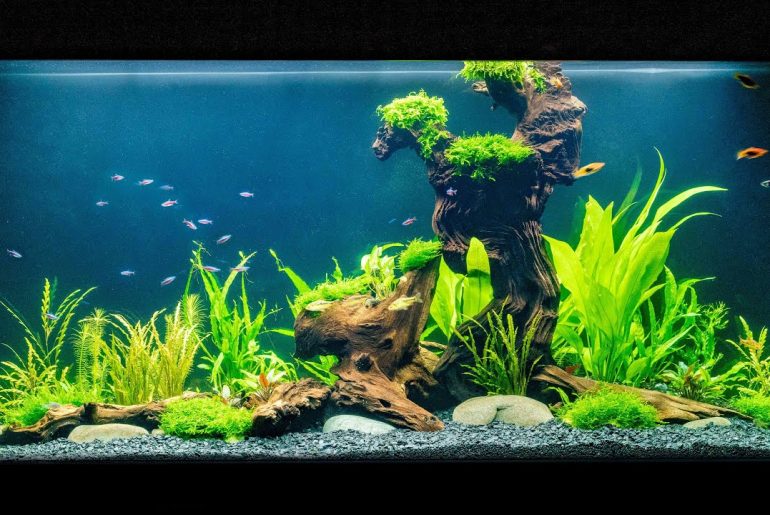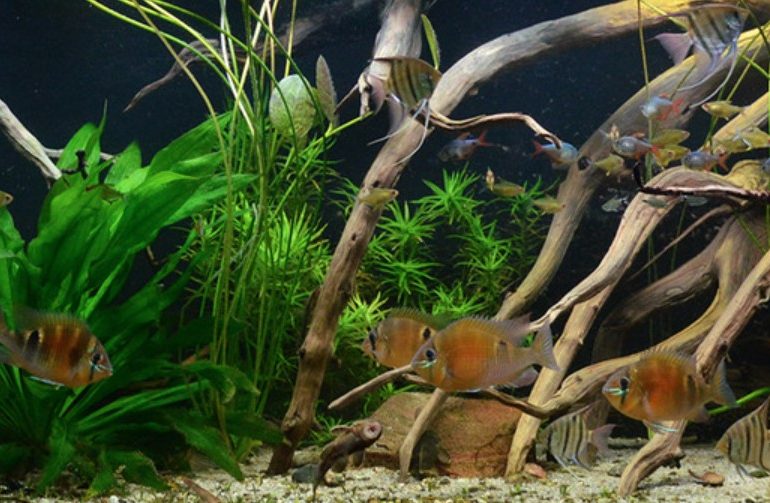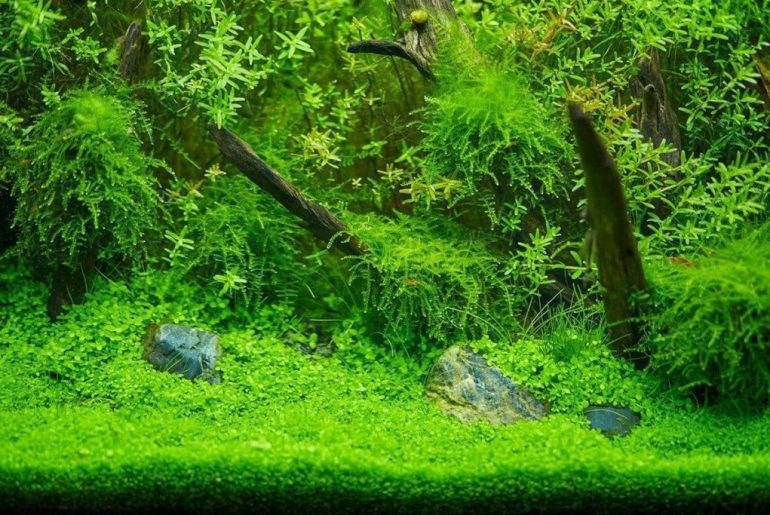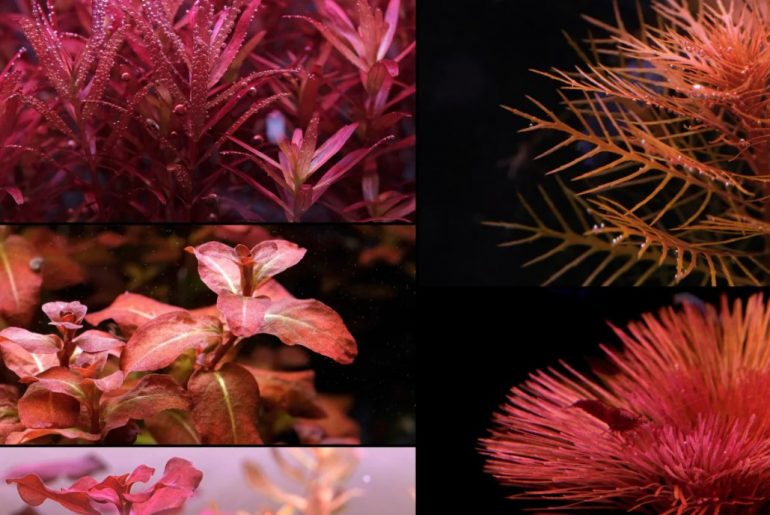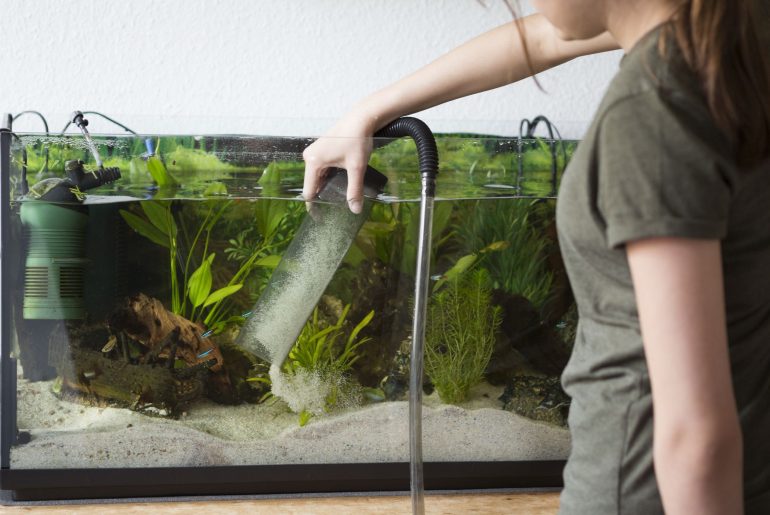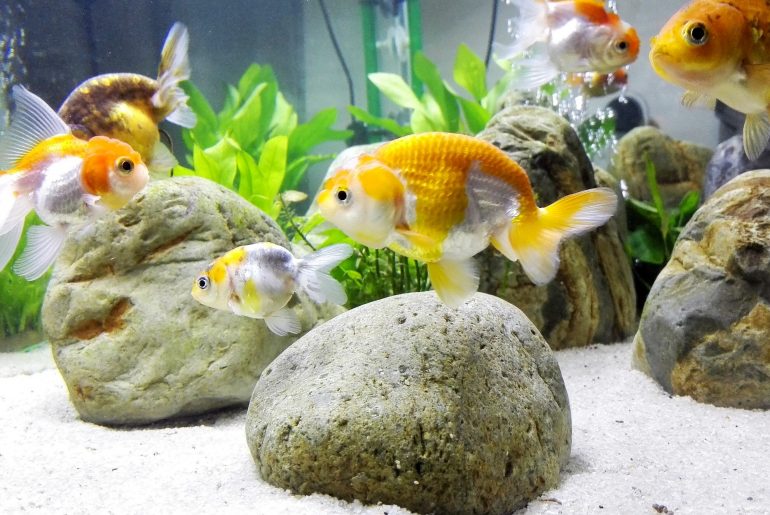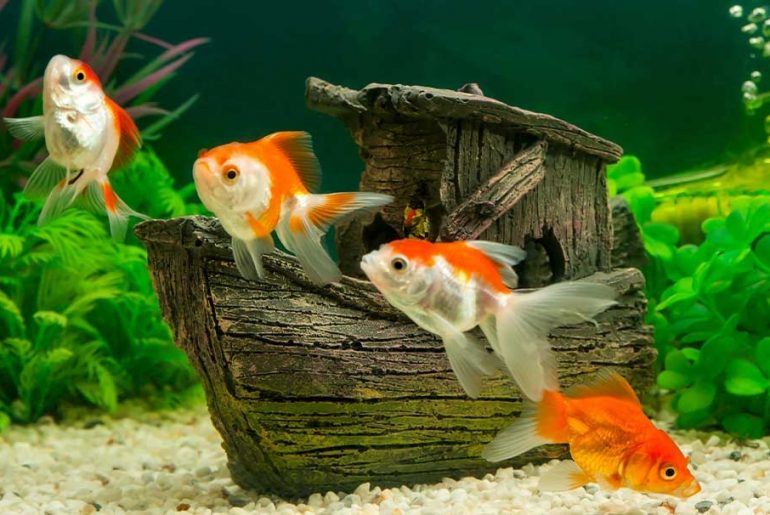Newcomers who want to set up an aquarium should first do some thorough research before getting started. In this article, we clarify the most important questions that arise when you design an aquarium and want to equip it with fish and plants. Don’t miss out on these tips for redesigning – maybe even experienced aquaristics fans can learn a thing or two for the redesign.
Redesign the aquarium: Which fish do I want to keep in the aquarium as a beginner?
A lot depends on this question: the size of the tank, the set-up of the aquarium, the aquarium technology and the choice of plants depend primarily on the stock, i.e. the animals that are to be cared for.
Community aquarium or species tank?
Getting started with aquaristics is usually done with a freshwater aquarium. For aquaristic beginners, the first choice is usually a community aquarium. In this, various less undemanding animal species such as ornamental fish or snails can be kept together in fresh water. A species tank with an animal species that does not need exceptional water values is also a good choice. It is advisable to plan some algae eaters for the aquarium, as they will eat up any algae growth in the aquarium water right from the start.
What do I have to pay attention to when planning the aquarium for beginners?
- Find out what water values the tap water has in your region. The most important parameters to be guided by are the pH and hardness of the water.
- Select fish for the aquarium that feel comfortable in this water. The values can still be easily adjusted in the aquarium, but aquaristic beginners usually lack the necessary know-how.
- In addition to the tank size and other parameters such as flow and lighting, the water values in the beginner’s aquarium form the most important basis for the selection of plants for the aquarium.
How big should an aquarium for beginners be?
The aquarium for beginners should not be too small: the larger the tank, the more stable the water parameters. Beginner’s mistakes are not as important here as in a small aquarium. Unfortunately, the nano aquariums, which have been so popular for a number of years, are often marketed to beginners. Designing such a small aquarium requires a lot of experience. Otherwise, an imbalance can quickly lead to algae in the aquarium or even to consequences for animals and plants. However, your well-being is always the priority for responsible aquarists.
If you would like to keep a lot of fish, you should definitely design a larger aquarium. The rule of thumb is one to two liters of water per centimeter of body length of the fish. Animals that need a lot of swimming space sometimes even need more space in the aquarium.
A beginner’s aquarium should not be chosen below the standard dimensions of 60 x 30 (54 liters tank capacity) – this is the absolute minimum for beginners. The bigger the pool, the better. You can often find inexpensive starter sets in stores that already contain technology such as filters and lighting. You can buy an aquarium plant set that is adapted to the tank size. A suitable base cabinet is also practical here, in which all utensils and accessories can disappear.
What technology do I need for my first aquarium?
You need a filter that is adapted to the size of the pool.
A high-quality fluorescent tube is essential for good plant growth.
If you want to care for tropical fish and aquarium plants, you need a heater.
When choosing the technique for the beginner’s aquarium, make sure that it is adapted to the size and type of tank. If you want to set up an aquarium for shrimp, the filter must be shrimp-proof, for example. Fish that love currents need an appropriate filter system. The light color and intensity of the fluorescent tube should be based on the needs of the plants in the aquarium and make the colors of the fish shine. If in doubt, seek advice from a specialist dealer or use specialist literature to find out tips on aquarium design.
What plants fit in an aquarium for beginners?
Once you know what fish you want to keep, it’s time to start planning the setup. An interesting overall picture of the aquarium is usually quite easy, even for beginners who are setting up an aquarium for the first time. There are only a few basic rules to follow. With a little practice, dreamlike underwater landscapes emerge. Our article on tank layout in the aquarium gives you some tips for setting up landscapes in the water and other ideas for aquarium design.
These areas exist when designing an aquarium
Basically, the aquarium is divided into three areas:
- foreground
- middle ground
- background
As a simple rule of thumb: low plants are used to create underwater landscapes, while taller aquarium plants are placed further back in the tank. Some interesting focal points are set by individual particularly pretty or eye-catching specimens – one speaks here of solitair plants. In most aquarium plant shops on the Internet or in specialist shops, the plants on offer are divided up in this way for easy orientation.
This takes you to the relevant departments in our shop. Browse through the categories and get an impression of the respective aquarium plant species:
- foreground plants
- midground plants
- background plants
- floating plants
Designing an aquarium: ideas for substrate, hardscape and plants
If you want to redesign your aquarium, in addition to creating a livable space for the fish, the goal is above all a beautiful appearance. The following tips show beginners and advanced aquarists how to design their aquarium.
Designing an aquarium: Tips for substrate
The substrate in the aquarium is the habitat for the animals in the water, ensures the supply of nutrients and gives the plants a secure footing. Ideally, build it up from two layers:
Start with the nutrient soil, which releases the most important nutrients into the aquarium water over the long term.
This is followed by the layer of gravel in which the plants take root.
The substrate in the aquarium for beginners usually consists of medium-grain gravel. Most aquarium plants feel comfortable in this. To create optical depth, pour it higher on the back wall than in front. When buying, make sure that the gravel is rounded. This is especially important if you want to keep bottom fish in the water. You can also design your aquarium with sand. However, since particles are quickly deposited in it, which can lead to inclusions of rot, you should use them sparingly.
Hardscape: Create an aquarium with stones and roots
Decorative objects such as stones and roots form the so-called hardscape, the “fixed” facility in the tank. It depends on your taste and the trimming, whether it should only be a few decorative elements or whether you want to create entire stone landscapes, for example. Based on the created landscapes, select the plants for the entry-level aquarium.
Designing the aquarium background: get creative!
The optically most attractive solution for the rear wall of the aquarium is the so-called structured rear wall. It gives the aquarium a natural atmosphere and can be made of different materials, such as granite, slate or quartz. The simpler alternative is a printed backing film, whether monochrome, with a sea ambience or complete landscapes.
Tip: A back wall is a great help for the fish. It helps them to orientate themselves in the water and avoids stress.
What do I have to consider when choosing plants as a beginner?
Needs of plants
Does the plant feel comfortable with the water parameters?
Does she receive light according to her needs?
Are the roots getting enough nutrients for healthy growth?
Does the growth height and shape correspond to the tank size and layout?
Some plants are very demanding. They need a lot of light or heavy fertilization with CO2. Undemanding aquarium plants thrive in almost every tank and forgive minor mistakes in the aquarium.
Needs of animals
What kind of planting does the animal species need? (Thickets to hide, large-leaved plants to scrape off when foraging, plenty of free swimming space to move, a floating plant cover as protection against threats, spawning grounds, …)
Do the stocking tend to eat aquarium plants?
All animals have special wishes for their environment – which differ significantly. If you want to set up an aquarium for shrimp, you choose completely different plants than in an aquarium for perch.
Choosing plants for the aquarium is great fun. Most of the time it is not that easy to decide between the many beautiful species. Especially at the beginning, we recommend that you use fast-growing aquarium plants for the design of aquariums. They absorb excess nutrients from the water via their roots, prevent algae from spreading in the water in the initial phase and forgive one or the other maintenance mistake in the aquarium for beginners. Slower-growing species such as cryptocorynes or anubias, like mosses for aquariums, are of particular interest once the tank has been run in. The more experience the new aquarium owner gains, the more demanding the plants and animals in the aquarium can be.
We wish you a lot of fun designing your aquarium with stones, setting up extraordinary landscapes and gaining your first experience in aquaristics!
We hope you enjoy planning and setting up the aquarium for beginners!


